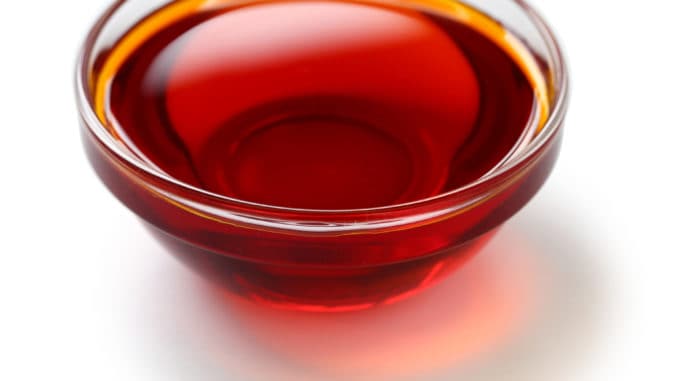
[cmamad id=”22189″ align=”center” tabid=”display-desktop” mobid=”display-desktop” stg=””]
Shocking new studies show what’s really happening to men when they consume this type of oil… Here’s what you need to know…

—-Important Message—-
New Discovery – Strong-Smelling Powder Fights Cancer and Alzheimer’s
It turns out that a strong-smelling powder holds the key to removing excess iron from building up in the brain and causing Alzheimer’s…
And it can even stop other toxins from leaking into your bloodstream and causing cancer.
Don’t worry because this powder may smell strong, but it’s natural and safe… And ultra cheap (it usually costs less than $3)…
Have you heard of men using this natural powder yet? Here it is if you’re curious…
———-
Should Men Be Using Red Palm Oil?
After a superficial analysis of the composition of red palm oil, you might get the impression that it’s one of the better plant oils.
Supposedly, it helps with heart disease and cancer… And supposedly it contains so many antioxidants and nutrients that it’s basically a natural dietary supplement.
It’s sold in health food stores and vitamin shops. You can get it in bottles and jars like other vegetable oils to use in your cooking.
Why are we all so thrilled with red palm oil?
Because at only 10%, red palm oil has one of the lowest concentrations of omega−6 fatty acids among all plant oils.
The linoleic acid concentration is practically the same as olive oil – but palm has more saturated fatty acids and less monounsaturated fatty acids.
Palm oil is also quite unique in its massive content of tocotrienols. (These are vitamin E subtypes consistently shown to inhibit cancer more than the common tocopherols).
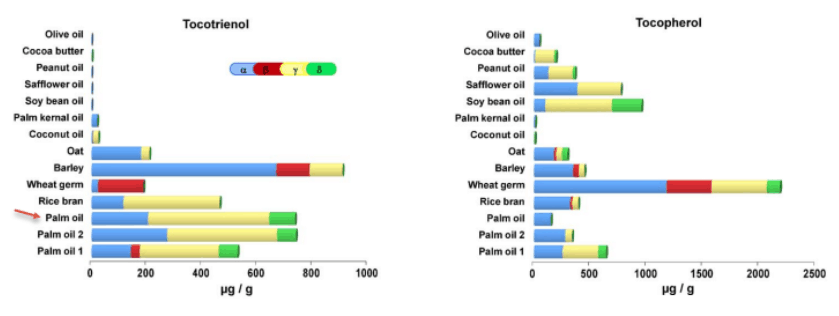
Palm oil is especially rich in gamma-tocotrienol. And that happens to be the most cancer-protective subtype found in animal studies.
This essentially means that palm oil has the most anti-neoplastic vitamin E profile out of any oil available.
So far so good…
“They showed that tocotrienols were more effective than alpha-tocopherol – and among the tocotrienols, gamma-tocotrienol was more effective than alpha-tocotrienol as an anti-tumor agent.”
[cmamad id=”22190″ align=”center” tabid=”display-desktop” mobid=”display-desktop” stg=””]
Tocotrienols differ from tocopherols only so far as they have a prenylated “tail.”
This property lends them more affinity for mitochondrial and nuclear membranes…
And this protects intracellular organelles from oxidation similar to how tocopherols protect the outer membrane:
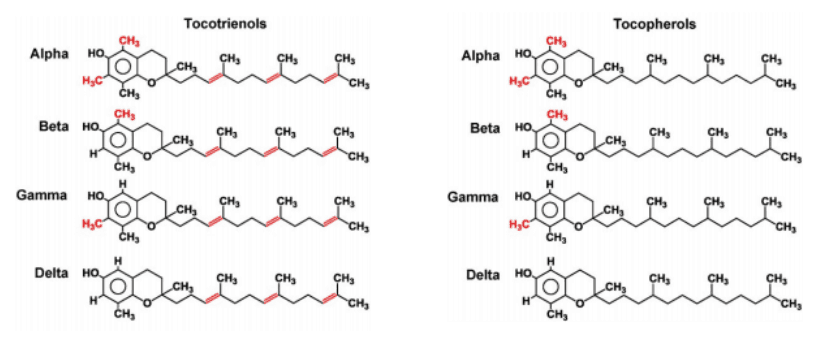
Now, we all probably want tocotrienols in our body for their mitochondrial antioxidant and cancer inhibitory effects. Of course we do!
Again, so far so good…
BUT there is good reason to think that the red palm oil sold in America is terrible stuff.
Due to the proven adulteration of red palm oil with Sudan Red Dyes – for a more brilliant color – the net effect of this oil would likely be negative.
And it might be worse. This could even cause some very serious issues.
First of all: Sudan Red Dyes is a proven carcinogen (Stiborová, 2002).
Civilized countries don’t allow these particular azo dyes are not allowed in food or drinks…
Yet they are routinely added to palm oil to increase the profits of unscrupulous plantation owners and wholesalers.
All four Sudan Dyes have been detected in red palm oil originating from West Africa, the world’s largest exporter of palm oil.
These dyes are often used to make red palm oil redder, or even to pass off golden palm oil as a superior product.
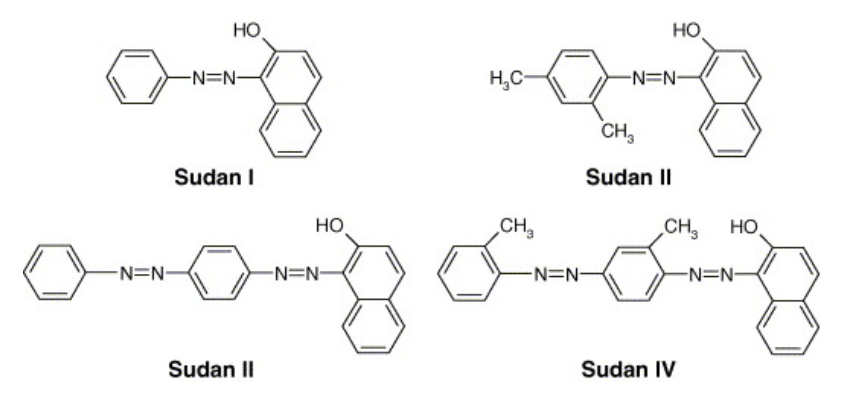
Sudan Dyes are never declared on the label…
And yet these dyes have been proven to exist in palm oil by the most elaborate chemical techniques we have.
The red azo dyes are also used to color spices such as saffron and paprika…
…yet the concentrations detected in palm oil greatly exceed those in any other product besides cosmetics!

This is not just some online rumor – you can see the results of this chemical analytical study below.
Chemists in the Washington DC area bought multiple brands of red palm oil both locally and online, and they tested twenty of these them using:
(1) High-pressure liquid chromatography
(2) Mass spectrometry
(3) UV absorbance
“Sudan I, II, III, and IV dyes are banned for use as food colorants in the United States and European Union because they are toxic and carcinogenic. These dyes have been illegally used as food additives in products such as chili spices and palm oil to enhance their red color.”
In total, they found that 4 out of 20 US brands were contaminated by Sudan IV Dye.
This makes 20% – about the same odds as hitting a flush with four spades and one card to go.
The concentrations were rather high: 25,000 ng/ml is equivalent to 25 mg per liter.
Most non-sulfated azo dyes (like Sudan IV) reliably cause liver sarcoma in animals.
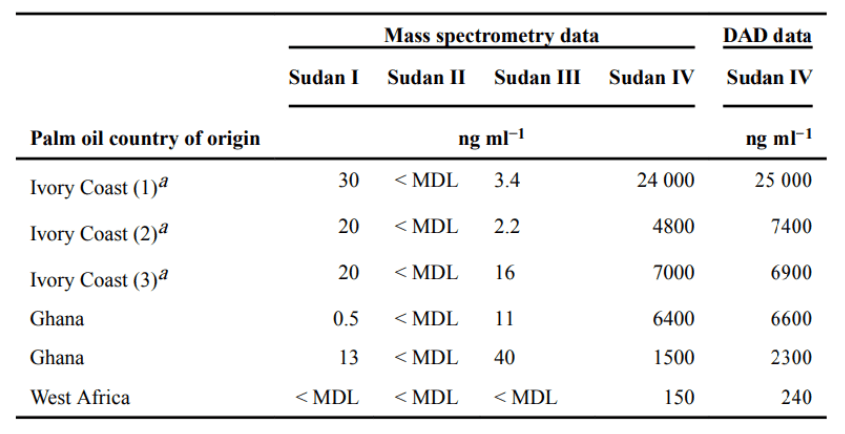
Obviously, this is not good at all…
And it would be much safer to just buy tocotrienols purified from barley oil and to use coconut oil instead.
Palm oil doesn’t even taste very good, so you would hardly be missing out on anything by avoiding it.
The European Union actually tests for Sudan dyes… And for this reason, most exported palm oil is safe.
However, America does not prevent all the bad stuff from coming through…
“Of these four contaminated samples, three were purchased from retail stores in the Washington, DC area that contain grocery items primarily imported from Africa, and one of the contaminated samples was purchased from an online retailer.”
“Yet the practice of adding Sudan dye is far more common in Africa than you’d assume by this one study alone. A 2016 analysis of 48 samples of African palm oil yielded a 96% prevalence of Sudan IV adulteration…”
So this is a ubiquitous practice. Aand the only thing stopping its ubiquitous consumption are US regulatory officials – who obviously aren’t doing their job.
Although liver carcinoma is not a good thing, this adulterated red palm oil could potentially cause something even worse:
Spanish toxic oil syndrome…
That is an often fatal wasting disease characterized by eosinophil infiltration of the lungs. (Eosinophil is a white blood cell thing.)
Spanish toxic oil syndrome had been caused by the addition of aniline yellow to rapeseed oil.
This was done to mark it for industrial use and “not for human consumption.”
This was then distilled by the Industria Trianera de Hidrogenacion refinery and sold to the working class Spanish population by RAELCO…
And… Aniline Yellow is an azo dye quite similar to Sudan Red IV.

Subsequent chemical investigation revealed that the toxic molecule is oleic acid anilide – formed from the Aniline Yellow reacting with oleic acid via distillation.
Is that disgusting enough?
Palm oil is also distilled in the purification stage and the Sudan Dye is often added beforehand by the pressers and wholesalers.
Palm oil contains 39% oleic acid – and also an azo dye…
So you could expect the exact same oleic acid anilide product to form from this combination that was responsible for the often fatal Spanish toxic oil syndrome…
“Although the process is commonly named ‘deodorization,’ it is actually a combination of three different operations: (a) distillation, i.e. stripping of volatile components; (b) actual deodorization, i.e. removal of odoriferous components; and (c) heating effect, i.e. thermal destruction of pigments while maintaining low side reactions such as ‘cis-trans’ isomerization, polymerization, etc.”
Spanish toxic oil syndrome is very similar to eosinophilia-myalgia syndrome, which is caused by ingesting too many tryptophan supplements.
Theoretical chemists tried to blame this on one impurity or another. But actual studies using pure tryptophan were able to recreate the condition.
Both of these conditions are characterized by eosinophilia, muscle wasting, pulmonary disease – and even death in some cases.
These two conditions were so similar that chemists tried to explain both of them in terms of their similar aniline compounds:
- In the case of eosinophilia-myalgia syndrome, it is bound to alanine
- In Spanish toxic oil syndrome, it’s bound to glycerol
These are now more or less the official explanations.
And that is despite the fact that neither one of those things actually causes any of the symptoms they are supposed to… even in massive doses.
Even pure aniline doesn’t do this…

The two things that could actually replicate the symptoms of these conditions are serotonin (via tryptophan) and oleic acid anilide (also a suspected product of red palm oil).
So what do serotonin and oleic acid anilide have in common?
Well, they both activate 5-HT2 and 5-HT7 receptors (serotonin receptors).
Exactly how tryptophan activates 5-HT receptors is immediately apparent, but how oleic acid anilide does it is not…
Oleic acid anilide is very similar to oleic acid amide (more commonly called oleamide).
This molecule will quickly put cats to sleep, even in small doses. And it has also been shown to potentiate the 5-HT2 and 5-HT7 receptors in very tiny concentrations.
This is somewhat similar to anandamide. Yet it works on the serotonin (5-HT) receptors and not on the cannabinoid (CB) receptors. (see below)
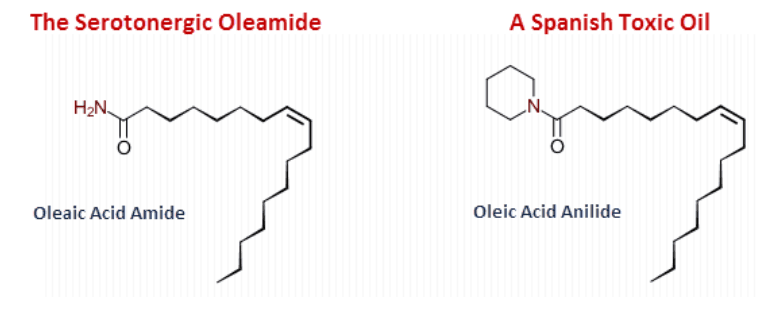
What is unusual about oleamide is its surprising potency…
It can double serotonin’s response at a mere 10 nM concentration.
Here is a graphical representation of the power of oleamide.
The serotonin concentration used was 1,000 times higher (10 μM) than the lowest concentration of oleamide shown to double the response (10 nM):
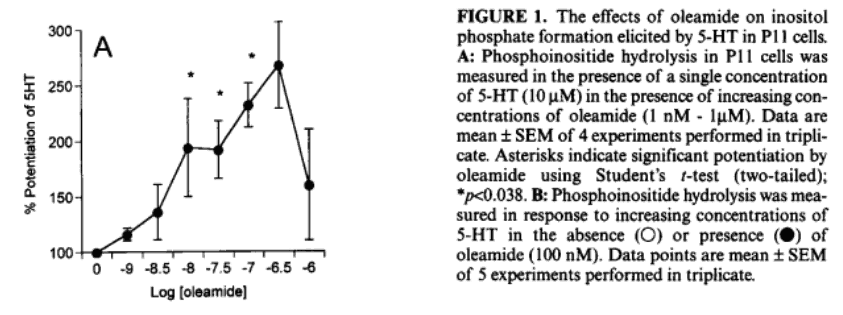
Yet, oleic acid amide isn’t quite oleamide exactly.
Studies using oleamide analogs, however, reveal that oleamide is not even the most potent synthetic.
N,N-Dimethyl oleamide was 156% more powerful than oleamide itself on the 5-HT2 receptor.
And N,N-Diethyl oleamide was 112% of oleamide’s strength.
It’s not much of a stretch to assume that oleic acid anilide activates the 5-HT2 receptor at least as well as oleamide.
And that’s because of its functionally similar substitution on the amide nitrogen.
So you don’t need two structurally similar molecules to explain the congruency between Spanish toxic oil syndrome and eosinophilia-myalgia syndrome if two disparate ones work on the same receptors in the very same way.
With that bit of science out of the way… How does this cause eosinophilia, muscle wasting, asthma, and death?
Here’s a bit more science…
Serotonin does have immunological functions…
It is released by platelets and mast cells in high concentrations. And is an established chemotactic factor for eosinophils.
(Chemotaxis is the movement of cells in response to chemical stimuli.)
This means that eosinophils will migrate along a serotonin concentration gradient…
And maybe this makes sense because scientists have noted high concentrations of serotonin emitting from parasites.
It seems that the main function of eosinophils is parasite destruction.
This is because they are the only immune cells that secrete a powerful neurotoxin and can induce muscle contractions (needed for parasite expulsion) with other proteins.
Eosinophils have been shown in vitro to be most effective against helminths – and they also secrete proteolytic enzymes to digest them.
(Helminths are parasitic worms… Don’t Google them!)
In addition, eosinophils are the most active immune cell at night as they are the only type stimulated by melatonin.
Eosinophils cause muscle wasting and asthma by their very presence.
And that explains most if not all the symptoms of Spanish toxic oil syndrome and eosinophilia-myalgia syndrome.
In turn, this reduces down to explaining the high eosinophil counts.
Serotonin can double the concentrations of certain cytokines – such as interleukin-1 beta (IL-1B) – in concentrations as low as 10 μM.
Proteolysis-inducing factor, which has been shown to cause muscle wasting directly, is a breakdown product of IL-1B.
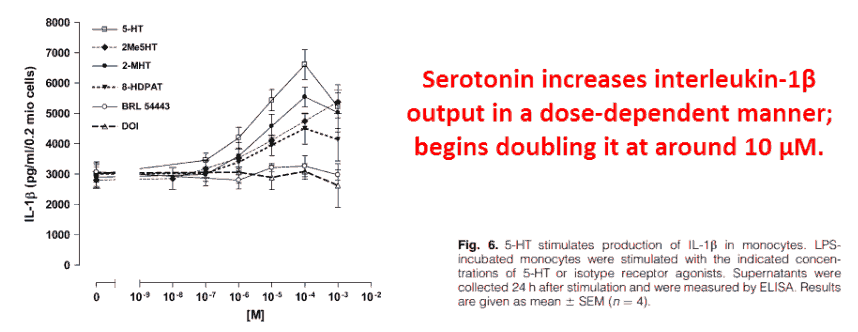
Yet interleukin-1B cannot explain the massive proliferation of eosinophils – for that you’d need to demonstrate increases in interleukin-5 or C-CSF.
Unfortunately, these two particular cytokines have never been tested for their response to serotonin.
Yet based on the available evidence, I think it’s possible that serotonin actually does stimulate eosinophilic cytokines.
Eosinophils act on muscle by releasing eosinophil basic protein, a protein that binds the muscarinic acetylcholine receptor-2.
This receptor is expressed most strongly on skeletal muscle, the lungs, and the heart, making it a good candidate for explaining specific Spanish toxic oil symptoms.
Atropine also binds and blocks the muscarinic acetylcholine receptor-2.
And atropine has also been shown to cause cachexia (wasting syndrome) and death in puppies.
“The chronic administration of atropine, therefore, produced in puppies a syndrome characterized by protracted cholinergic inhibition, stimulation followed by depression of the central nervous system, loss of weight, and increasing cachexia.”
Along with the eosinophil neurotoxin also released, you don’t need much more to explain Toxic Oil Syndrome and eosinophilia-myalgia syndrome than the high eosinophil counts.
Eosinophils are always found in cases of extreme asthma when they’re looked for, explaining the breathing problems through its most consistently associated biomarker.
Eosinophil basic protein is used as a blood-associated biomarker for asthmatic disease and induces it when injected.
Eosinophils could also synergize with interleukin-1B, the cytokine precursor to proteolysis-inducing factor, to cause muscle wasting and death.
And both of these can be induced by a serotonergic response in peripheral immune cells.
Serotonin receptors could also explain why oleic acid anilide is quite toxic to all rabbits and dogs, yet only to about half of all rodent strains tested.
Many strains of lab mice are still nocturnal and therefore have different serotonin/melatonin “wiring.”
Nocturnal animals must respond to melatonin and serotonin in a different manner than us – otherwise they would fall asleep when they should be awake.
Regardless of how it works, there is undeniable evidence that Spanish toxic oil syndrome has been caused by an azo dye mixed with oil and distilled…
And that is exactly what happens with highly refined red palm oil originating from West Africa.
So, without being 100% certain of its chemical mechanism of formation and its biochemical-physiological response, it seems clear that it is toxic as hell.
Perhaps there hasn’t been a publicized outbreak yet simply because red palm oil is most often consumed by yuppies in small yuppie-sized amounts.
There’s good reason to believe the Spanish working class simply consumed more toxic oil than palm oil consumers would.
The lower popularity of red palm oil coupled with wide distribution ensures that known cases would be few and far between.
In other words, it would be epidemiologically obscured by its sporadic occurrence.
Unrefined palm oil should be much safer – but you wouldn’t actually want that either…
That’s because the high lipase content of the palm fruit leads to an unusually high fatty acid concentration in its oil…
So it goes rancid easily, despite large concentrations of tocotrienols and saturated fatty acids.
And that means it is not really an option either. I certainly would never buy red palm oil again…
If you already have some, maybe you could find another use for it – perhaps an automotive use.
—-Important Message from Vic, a Matt Cook Student—-
“Horny? But Not Looking to Date?”
I get it – sometimes single guys just need to get laid. Some good, old-fashioned, no-strings-attached sex.
It makes sense – because sex is good for men.
And some men aren’t in the right headspace to date a woman yet – maybe they’re fresh off a divorce or getting over an ex.
But any guy should still be able to get laid when he needs to… It refreshes your focus and your mental outlook, it boosts your mood and testosterone, and it has loads of other benefits.
So here’s what you need to do to get a nice young woman to come over and have sex with you…
Just send her these 3 “weird” little emails.

———-

- Amoako-Mensah, Jacob. Assessment of the prevalence of Palm Oil adulteration with Sudan IV dye in the Greater Accra Region. Diss. 2017.
http://ir.knust.edu.gh/xmlui/bitstream/handle/123456789/11013/Jacob%20Amoako-Mensah.pdf?sequence=1 - Genualdi, Susie. "Method development and survey of Sudan I–IV in palm oil and chilli spices in the Washington, DC, area." Food Additives & Contaminants (2016)
https://www.ncbi.nlm.nih.gov/pmc/articles/PMC4888373/pdf/nihms787454.pdf - Boger, Dale. "Structural requirements for 5-HT₂₇ and 5-HT₁ serotonin receptor potentiation by the biologically active lipid oleamide." Proceedings of the National Academy of Sciences (1998)
http://www.pnas.org/content/pnas/95/8/4102.full.pdf - Aggarwal, Bharat. "Tocotrienols, the vitamin E of the 21st century: Its potential against cancer and other chronic diseases." Biochemical Pharmacology (2010)
http://www.meltorganic.com/wp-content/uploads/2011/06/Tocotrienols-the-vitamin-E-of-the-21st-century-Its-potential-against-cancer-and-other-chronic-diseases.pdf - Gibon, Véronique. "Palm oil refining." European journal of lipid science and technology (2007)
https://s3.amazonaws.com/academia.edu.documents/46971006/Palm_oil_fractionation20160703-14141-2z3mx1.pdf?AWSAccessKeyId=AKIAIWOWYYGZ2Y53UL3A&Expires=1537598379&Signature=NArY%2BUDHXQgA0O%2FhEfu6rDdB850%3D&response-content-disposition=inline%3B%20filename%3DPalm_oil_fractionation.pdf
- Health-promoting effects of red palm oil: evidence from animal and human studies.
https://www.ncbi.nlm.nih.gov/pubmed/28158744 - By the way, doctor: Is palm oil good for you?
https://www.health.harvard.edu/staying-healthy/by_the_way_doctor_is_palm_oil_good_for_you
